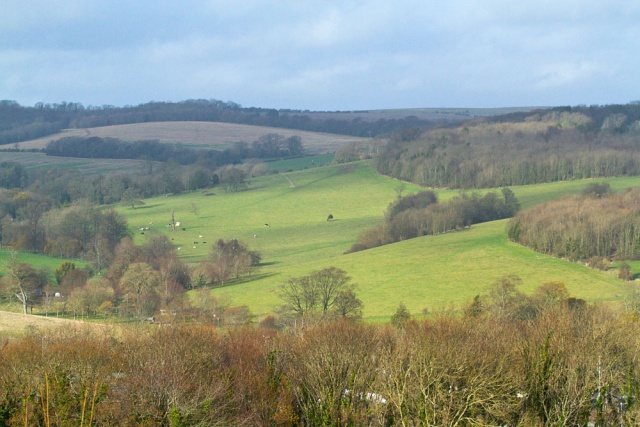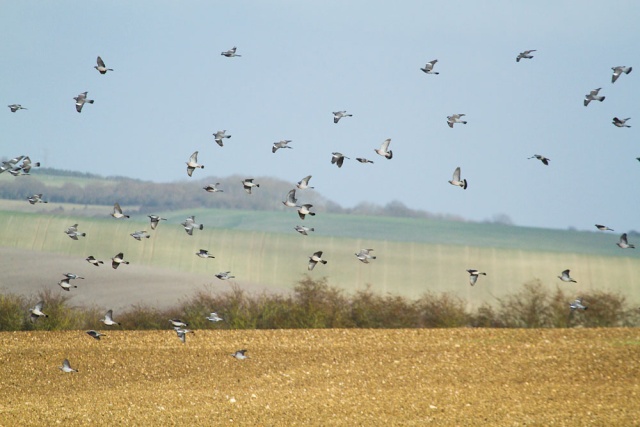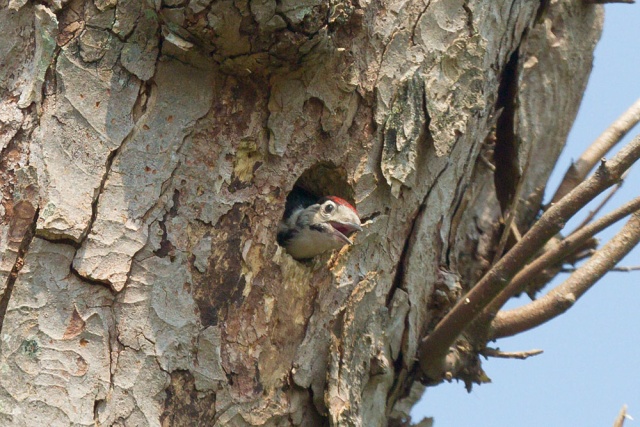Just a couple of landscapes from the day, before the winds and rain really started up. This first shot, taken at lunchtime, is looking out over Stanmer Park.
The second is a field at the edge of our campus. The pigeons are making the most of the stubble, but occasionally rise up in large flocks.
Now for the video. This was caught overnight on the trail cam. Keep watching (it's not long). At about the mid point, the second of the two badgers discovers the trail cam.
I mentioned the winds today, and sadly one of my favourite trees (the picture explains why I like it so much) at the edge of our car park at work came crashing down into a small brick hut. No-one was hurt, thankfully, but it does mean that I won't get any more shots like this one from earlier in the year. 
Camera note: all shots taken with the Canon 7D and EF 100-400mm f/4.5-5.6L USM IS lens. Video from the Bushnell Trophy Cam
derWandersmann
23 Nov 2012That's quite a handsome park, Words … it looks like a painting.
The pigeons taking off as a unit like that makes me wonder if this type of bird behaviour is related to schooling behaviour in fish … both behaviours would have a tendency to confuse a predator, much like "window" ejected from a warplane.
Thank heavens the badger didn't decide to sample the plastic!
Pity about the tree … hollow trees do have that tendency to fall down.
serola
23 Nov 2012I do like the first two shots a lot :happy:
And what comes to those badgers, the other one literally seem to find the trail cam 😆 I just hope they do not caught a fight over food with the foxes :insane:
gdare
24 Nov 2012That must have been very old tree :left:
Words
25 Nov 2012Darko, I'm not sure how old that tree was but we have a fungal disease threatening the ash tree population here, some of which are 1000 years old. If it spreads our whole landscape could change in a very few years. 🙁
Words
25 Nov 2012dW, Stanmer Park is very beautiful. It's an old estate that is now part of the South Downs National Park. A lot of the tree planting around here was carried out in the late 18th/ early 19th century, partly to provide timber for ships (Napoleonic Wars).
Interesting observation about the pigeons. That sounds right. The protection of the flock/school being paramount.
The camera survived the badger's investigation (thankfully); unlike the tree, which succumbed to the winds. The general policy is to leave dead trees standing as wildlife habitat.
Words
25 Nov 2012Sami, thanks. So far the foxes and badgers have avoided fights. Mainly because the badgers are young and the foxes too sensible (most of the time). Spring is more risky, when they both have young and food is more precious.
serola
26 Nov 2012Thanks for the information Words :up: Always interesting to find out how different animals behave.
gdare
26 Nov 2012In BC, it is some kind of beetle that devastates pine forests. When we were in Manning park this summer, I've seen entire hills covered with dry dead trees :awww: They say that several very cold winters could remedy that but I doubt it will happen soon :left:
derWandersmann
26 Nov 2012I've just been hearing about that on the radio, Dare … it sounds very ominous.
Here in Wisconsin we're fighting an action against the Emerald Ash-Borer which leaves a little, barely noticeable D-shaped hole in the bark. It burrows around underneath the bark, eating the cambium, I think, and pretty soon the tree can't feed itself and dies. This could be something that might spread … it's only really noticeable when the trees start dying.
The fungus that's bothering the English ash may be basically the same thing that causes what we call "oak-wilt" here … if I recall, the fungus gets inside the plumbing system of the tree and chokes it, because it multiplies there. It's spread by something like a worm, I think. Oak and Ash are fairly closely related, I think … the wood sure looks the same.
Possibly a little "Oak, Ash, and Thorn" are required … know any Druids?
Words
27 Nov 2012Darko/dW, it's easy to forget how vulnerable our natural habitat is. The ash (which is under threat) is the mainstay of most of our woodland so its loss will have a massive effect on the countryside and the wider ecology. The jury is still out on the cause, but 'ash die-back' has been in Europe for some while and we continued to import new stock even though there was a risk. The spores may also have blown in across the water, but I have to say it looks like we're taking action too little and too late. We stand to lose millions of trees.
Where we are in Brighton we have one of the last collections of elm trees in the UK (most of the rest of the country lost theirs to Dutch Elm disease). That is spread by a beetle and they've used all kinds of strategies to protect the trees over the years, including pheromone traps.
derWandersmann
27 Nov 2012They've used massive antibiotic injections (all right, stop laughing!) successfully in some cases over here.
Words
28 Nov 2012Originally posted by derWandersmann: